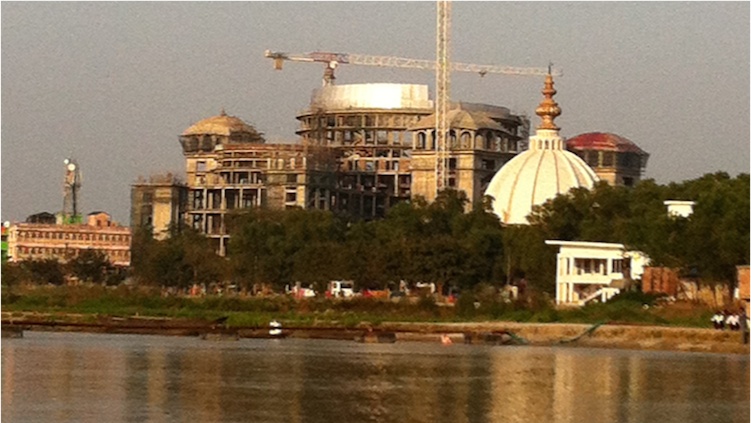New TOVP Film Released As Construction Progresses Steadily
By Madhava Smullen | Авг 21, 2014

A brand new professionally-shot documentary about the construction of ISKCON’s flagship temple, the Temple of the Vedic Planetarium in Mayapur, West Bengal has just been released, as the initial burst of progress settles to a slower yet steady pace.
The documentary is the second in a multi-part series, after “The Cosmos out of the Rice Fields,” which explored the history of the temple — ISKCON Founder Srila Prabhupada’s dream – and how construction began in early 2010.
The new film, “Unity In Diversity – A Community Creates The TOVP,” focuses more on the community behind the ambitious project, and points out that it is just as much selfless dedication, respect, and cooperation than bricks and marble that have been the temple’s main building blocks.
Scenes in the film give an inside look at a day in the life of Mayapur, including time with devotees working in the festival, kitchen, and Deity departments, as well as the school.
Directed by professional documentary film-maker Krisztina Danka (Krishna-lila Dasi) for her studio Karuna Productions, “Unity in Diversity” immerses the viewer in the inspirational atmosphere of Mayapur through bright, beautifully shot visuals and uplifting devotional music.
“One of the film’s goals is to simply raise awareness of the Temple of the Vedic Planetarium and of Srila Prabhupada and Krishna consciousness in general,” says Ambarisa Das (Alfred B. Ford), executive producer of the documentary and chairman of the TOVP. “The other is to help with fundraising.”
Ambarisa, who is the great-grandson of auto magnate Henry Ford, and who received specific instructions to build the TOVP from his guru Srila Prabhupada, has already contributed over $20 million to the project. With contributions from other donors, around $30 million has been raised so far.
But that’s still only half of the amount required to complete the temple. Conceived by Srila Prabhupada in the 1970s and finally coming to fruition, the TOVP will be thirty storeys high – taller than St. Paul’s Cathedral in London – with a 300-foot-high dome inspired by classical European architecture.
Inside the temple will be a huge, detailed chandelier model of the universe as described in the fifth canto of the ancient Vedic text Srimad Bhagavatam, and an ornate altar housing Sri Sri Pancha-Tattva, Sri Sri Radha-Madhava, and the Six Goswamis of Vrindavana. There will also be separate wings for the eponymous Vedic planetarium itself and for the Deity of Lord Nrsimhadeva. The whole temple will be set amongst beautifully landscaped gardens and walkways.
It’s no wonder that Ambarisa and his team will have to raise at least another $30 million to make all this a reality, and they’re working hard, travelling around the world to inspire would-be donors.

The dome structure from within
“I went to South Arica this spring, and with the full support of the ISKCON leaders there, we managed to raise close to $4 million,” he says. “This fall, we plan to visit different countries in the Middle East. Then we’ll turn our attention to India. The fundraising is going well. We’re getting more and more support from ISKCON devotees.”
A wide variety of donation styles are being made available to accommodate different incomes at tovp.org: donors can give one or more square feet of the temple for $150 each; a golden tile on Lord Nrsimhadeva’s altar that will bear their name for $1,000; or a golden brick on Sri Chaitanya’s altar, also inscribed with their name, for $1,600, amongst other options.
And Ambarisa says that the funds needed can be raised in stages, so that it will be less daunting — $10 million to bring the construction to the point where the Deities can be safely moved in; another ten to complete the interior and exterior of the temple; and a final $10 million or more for the gardens and other finishing touches.
Currently, workers are focusing on completing the temple’s superstructure, and are halfway through building its huge dome. Once that is done, they will start applying pure white Vietnamese marble to the exterior of the temple, and installing the ceramic tiles that will give the dome its unique blue color.
Meanwhile various other aspects of the project are being designed, from the acoustics in the kirtan hall to the planetarium wing exhibits, to the altar, which will be built with first-class blue Bolivian marble, to the unique rose-tinted brass murti of Srila Prabhupada, to be built by renowned ISKCON artist Locana Das.

The altar under construction
With the work becoming more and more specialized, progress is slowing down slightly, but still continuing at a steady pace. The temple may not be ready for the Deities to move into by ISKCON’s 50th anniversary in 2016 as previously planned, but Ambarisa is optimistic that some notable level of completion will be celebrated then, and is determined to see the Deities move in before too long.
Of course, with all the skilled workers and plans in place, everything could happen a lot more quickly if enough funds are raised. And Ambarisa, who has put his money where his mouth is, offers some reasons why he has felt so inspired to contribute and why he hopes others will too.
“This temple will be a place where all devotees can feel like they’re home and are part of Prabhupada’s family, where they can absorb the spiritual atmosphere and feel rejuvenated,” he says. “It will be the Brihat Mridanga from which the message of Srila Prabhupada and Sri Chaitanya will be vibrated around the world. And it will be a world-class tourist attraction for the general public that people can come away from not with photos or souvenirs but with actual spiritual advancement.”
To donate towards the TOVP using Paypal, check or bank transfer, and to see the latest photographs showing the TOVP construction progress, please visit www.tovp.org.















